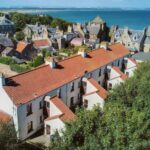Born in 1893, Florence Donnelly’s parents and grandparents had come West during the Gold Rush. As a self-described “historical nut,” her love of history came early. Donnelly remembers her grandmother’s stories about the Gold Rush, stagecoaches and Native Americans.
Her father purchased land in 1905, building a house at 117 C St. in San Rafael. After attending the B Street and Fourth Street schools in the area, she would go on to graduate from San Rafael High School and UC Berkeley.

In 1930, Donnelly started at the Marin Independent Journal. She began with county news, which included courthouse coverage at the end of Prohibition, when the courts were filled with rum runners and criminal gangs. Donnelly went on to become the social editor for more than 20 years.
Later, she went on to be the founding editor of the Marin Magazine supplement. In 1935, she was one of the main founders of the Marin County Historical Society, now the Marin History Museum. In addition, she provided the historical research for the county’s centennial pageant produced in 1949.
Donnelly married state Sen. Hugh P. Donnelly and they had one son, James Holland Donnelly.
After divorcing, she moved back to her parents’ home and lived there the rest of her life. It wasn’t just IJ readers who took notice of Donnelly’s writing and community involvement. In 1952, the California News Publishers Association gave her an award for the best women’s page among all the California newspapers.
On March 4, 1953, the San Rafael Improvement Club honored Donnelly for her outstanding service to the club and civic work in the community at a standing-room-only luncheon. The salute included a theatrical production with songs and skits, which expressed their appreciation of Donnelly’s fine qualities, including a chorus of women who wore aprons made of pleated newspapers. At one point, a bouquet of American beauty roses was presented to her.
During her speech, Donnelly said, “I’ve been in newspaper work for most of my adult years and have considered myself a fortunate woman.” In June 1964, Donnelly retired from her position as women’s page editor and took on a history post for the IJ. She supplied the paper with historical articles for the Marin Magazine supplement on Saturdays.
In the mid-1960s, Donnelly wrote a series of gritty articles profiling San Quentin prison through the decades. Called “The San Quentin Story,” the series began with the start of the prison in the early 1850s with 50 prisoners (both men and women) aboard a ship moored in upper San Pablo Bay to the first two-story cell block built in 1854. She reported that women were moved from the “Hen House” at San Quentin in 1933 and relocated to Tehachapi.
Donnelly did not hold back about savage treatment, turmoil and bloodshed at the prison. The last article focused on Warden Clinton Duffy, who was known for his progressive and enlightened prison administration. Donnelly reported that “one of his first acts was to remove the doors from the dungeon entrance, making the space into a canteen for convicts.
” The food and educational opportunities drastically improved. During World War II, convicts learned vocational trades that helped the war effort. Donnelly held a variety of positions within the historical society and was made an honorary director at both the historical society and the San Rafael Improvement Club.
She was also a member of the Business and Professional Women’s Club. Donnelly died on June 10, 1969, at age 76. As a woman considered ahead of her time, Donnelly’s legacy has inspired many generations over the years.
History Watch is written by Lane Dooling, marketing and social media coordinator at the Marin History Museum, marinhistory.org . Images included in History Watch are available for purchase by calling 415-382-1182 or by email at info@marinhistory.
org.



















